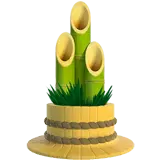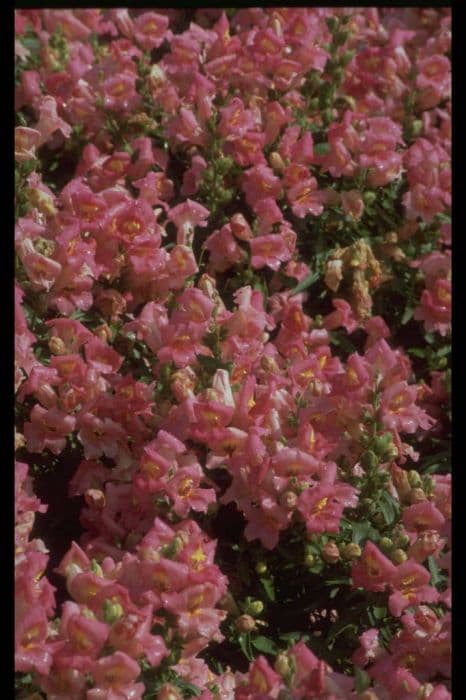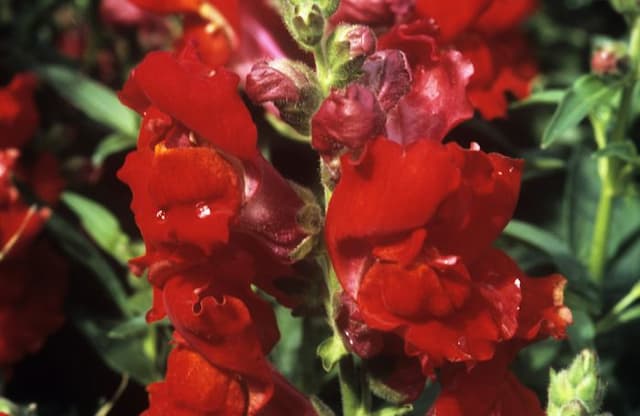Beardtongue Penstemon 'Connie's Pink'

ABOUT
Penstemon 'Connie's Pink', is a delightful perennial plant that adds a splash of color to any garden. This plant is distinctly recognized for its beautiful tubular flowers that boast a soft pink hue. These blossoms are arranged neatly on tall spikes that rise gracefully above the foliage. The flowers have a slightly flared mouth, giving them a bell-like appearance which is aesthetically appealing to both gardeners and pollinators such as hummingbirds. The foliage of Penstemon 'Connie's Pink' is also quite attractive, consisting of lance-shaped leaves that have a lush green color. The leaves are arranged oppositely on the stems, creating a neat and organized look that enhances the overall texture of the plant. The contrast between the green of the leaves and the pink of the flowers is striking and provides a lovely visual interest throughout its blooming period. Penstemon 'Connie's Pink' has a bushy habit, with the flowers perched on the upper part of the stems, making it a good choice for borders or as part of a mixed flower arrangement in a garden bed. This plant is known for its prolonged flowering season, which adds color and life to garden spaces for an extended time. It's a hardy selection that can bring charm and beauty to various landscaping designs without the mention of its specific measurements.
About this plant
 Names
NamesSynonyms
Beardtongue, Connie's Pink Beardtongue
Common names
Penstemon 'Connie's Pink'.
 Toxicity
ToxicityTo humans
Beardtongue 'Connie's Pink', generally known as beardtongue, does not have a reputation for being toxic to humans. There are no well-documented cases of poisoning from this plant, and it is not known to contain compounds that are harmful when touched or ingested. If any symptoms do appear upon ingestion, which is unlikely, they may be due to individual sensitivity. Always exercise caution and avoid ingesting plants that are not specifically grown for consumption.
To pets
Beardtongue 'Connie's Pink' is also known to be non-toxic to pets. There are no known toxic compounds within beardtongue that would cause harm to dogs, cats, or other domestic animals if ingested. It is generally considered safe around pets, but ingestion of any non-food plant can potentially cause mild gastrointestinal upset due to the novelty of the plant material in the pet's digestive system. If any unusual symptoms occur after ingestion, it is best to consult with a veterinarian.
 Characteristics
CharacteristicsLife cycle
Perennials
Foliage type
Semi-deciduous
Color of leaves
Green
Flower color
Pink
Height
2-3 feet (0.6-0.9 meters)
Spread
2 feet (0.6 meters)
Plant type
Herb
Hardiness zones
8
Native area
North America
Benefits
 General Benefits
General Benefits- Attracts pollinators: The brightly colored flowers of the Beardtongue are known to attract bees and butterflies, promoting pollination in the garden.
- Drought tolerant: Once established, this plant has low water requirements, making it suitable for xeriscaping or dry climate gardens.
- Low maintenance: Beardtongue generally requires minimal care, thriving in a variety of conditions without needing regular watering or fertilization.
- Long blooming period: It has a long flowering season, providing color and interest in the landscape from late spring through summer.
- Erosion control: The root system of the Beardtongue can help stabilize soil and prevent erosion on slopes or in areas with loose soil.
- Decorative cut flowers: The blooms can be used as cut flowers to create attractive arrangements for indoor decoration.
- Resistant to pests and diseases: Beardtongue is notably resistant to many common pests and diseases, reducing the need for chemical treatments.
- Non-invasive: Unlike some other ornamentals, Beardtongue doesn't typically spread uncontrollably, making it a good choice for gardeners looking for plants that stay put.
 Medical Properties
Medical PropertiesThis plant is not used for medical purposes.
 Air-purifying Qualities
Air-purifying QualitiesThis plant is not specifically known for air purifying qualities.
 Other Uses
Other Uses- The Penstemon can be used in the creation of natural dyes, with different parts of the plant yielding various shades and colors for fabric dyeing.
- Due to its unique aesthetic, the Penstemon can be employed in art projects, such as pressing the flowers for inclusion in botanical illustrations or herbarium collections.
- The plant's stalks can be dried and used in rustic crafts or as a part of dried floral arrangements, serving as a reminder of the beauty of the garden in winter.
- The Penstemon's tubular flowers can serve as inspiration for design and architecture, influencing shapes and forms in decorative elements or structures.
- The Penstemon, with its bright flowers, can be used in photography as a natural contrasting element for macro and nature photography.
- In educational settings, the plant can serve as an example for studies on pollination and the relationship between flower shape and its pollinators.
- Penstemon can be employed as a living mulch, providing ground cover and helping to retain soil moisture and reduce weed growth.
- Used as companion plants, Penstemons can support biodiversity in gardens by attracting pollinators and beneficial insects that aid in the health of surrounding flora.
- The Penstemon might find use in sensory gardens due to their soft textures and inviting shape, which can stimulate touch or sight for educational and therapeutic purposes.
- In culinary settings, though not commonly eaten, the petals of some Penstemon species could be used as edible decorations for salads or desserts, provided they have not been treated with pesticides.
Interesting Facts
 Feng Shui
Feng ShuiThe Beardtongue is not used in Feng Shui practice.
 Zodiac Sign Compitability
Zodiac Sign CompitabilityThe Beardtongue is not used in astrology practice.
 Plant Symbolism
Plant Symbolism- Admiration: Penstemon plants are often associated with admiration due to their striking flowers and resilient nature, creating a parallel to the human qualities of endurance and beauty admired by others.
- Boldness: The vibrant colors of 'Connie's Pink' Penstemon symbolize boldness and a willingness to stand out in the crowd.
- Diversity: Penstemons come in a wide range of colors and varieties, symbolizing diversity and the beauty found in different forms and expressions.
- Health: Many species of Penstemon are used in traditional medicine, thus they can symbolize good health and healing.
- Hardiness: As Penstemons are known for their ability to thrive in tough conditions, they can represent hardiness and the ability to withstand challenges.
 Water
WaterBeardtongue, commonly known as Penstemon 'Connie's Pink', prefers consistent moisture, so it's crucial to water it deeply once a week, providing about 1-2 gallons per plant each time, depending on the weather conditions. During periods of drought or extreme heat, you may need to increase the frequency to twice a week. Ensure the soil is well-draining and water at the base of the plant to avoid wetting the foliage, which can lead to fungal diseases. It's important not to overwater, as this can cause root rot, so let the soil dry out slightly between waterings.
 Light
LightBeardtongue thrives in a location with full sun, which means at least 6 to 8 hours of direct sunlight a day. The best spot for Penstemon 'Connie's Pink' would be in an area where it receives unfiltered, bright sunlight for most of the day. Some afternoon shade might be beneficial in extremely hot climates to prevent leaf scorch.
 Temperature
TemperatureBeardtongue is a hardy plant that can withstand a temperature range of 20°F to 90°F, making it suitable for many climates. The ideal temperature conditions for Penstemon 'Connie's Pink' are between 60°F and 75°F, which promote healthy growth and flowering. These plants are resilient but may need protection from frost or extreme cold below 20°F.
 Pruning
PruningPruning Beardtongue is necessary to promote bushier growth and more flowers. Penstemon 'Connie's Pink' should be pruned back in late winter or early spring before new growth appears. Deadheading spent blooms during the growing season will encourage more flowers. Pruning every year is recommended to keep the plant healthy and vibrant.
 Cleaning
CleaningAs needed
 Soil
SoilThe ideal soil mix for Beardtongue 'Connie's Pink' should be composed of loamy, well-draining soil with added organic matter such as compost. The soil pH should be slightly acidic to neutral, ranging from 6.0 to 7.0.
 Repotting
RepottingBeardtongue 'Connie's Pink' generally does not require frequent repotting and may be repotted every 2-3 years to refresh the soil and accommodate root growth.
 Humidity & Misting
Humidity & MistingBeardtongue 'Connie's Pink' prefers moderate humidity levels but is adaptable to the humidity conditions typically found in temperate climates without needing any special adjustments.
 Suitable locations
Suitable locationsIndoor
Place in bright, indirect light; water moderately.
Outdoor
Full sun to part shade, protect from harsh elements.
Hardiness zone
4-9 USDA
 Life cycle
Life cyclePenstemon 'Connie's Pink', commonly known as Beardtongue, begins its life cycle when its small, bell-shaped seeds germinate in the spring, given adequate warmth and moisture. The seedlings grow into young plants with a rosette of leaves at the base, developing a deep root system. As the plants mature, they produce upright stems with lance-shaped leaves, and in late spring to early summer, they bloom with clusters of tubular pink flowers attractive to pollinators like bees and hummingbirds. After pollination, the flowers fade and seed capsules form, which dry and release seeds for the next generation. During the growing season, Penstemon 'Connie's Pink' may experience vegetative propagation as well through division of its clumps. As perennials, these plants go dormant in the fall and winter, with the foliage dying back, and then they regrow from their rootstock when conditions become favorable in the spring.
 Propogation
PropogationPropogation time
Spring to Early Summer
The most popular method of propagation for Penstemon 'Connie's Pink', also known commonly as Beardtongue, is by cuttings. To propagate by cuttings, select a healthy, non-flowering stem from the desired plant during late spring or early summer. Cut a piece of stem about 4 to 6 inches (approximately 10 to 15 centimeters) long, ensuring there are several leaf nodes present. Remove the leaves from the lower half of the cutting, and dip the cut end into a rooting hormone to encourage root development. Plant the cutting in a well-draining potting mix and keep it moist but not waterlogged. Cover with a plastic bag or place in a propagator to maintain humidity, and keep in indirect sunlight. Roots typically develop within a few weeks, after which the new plant can be gradually acclimated to ambient conditions and eventually transplanted to the garden.









